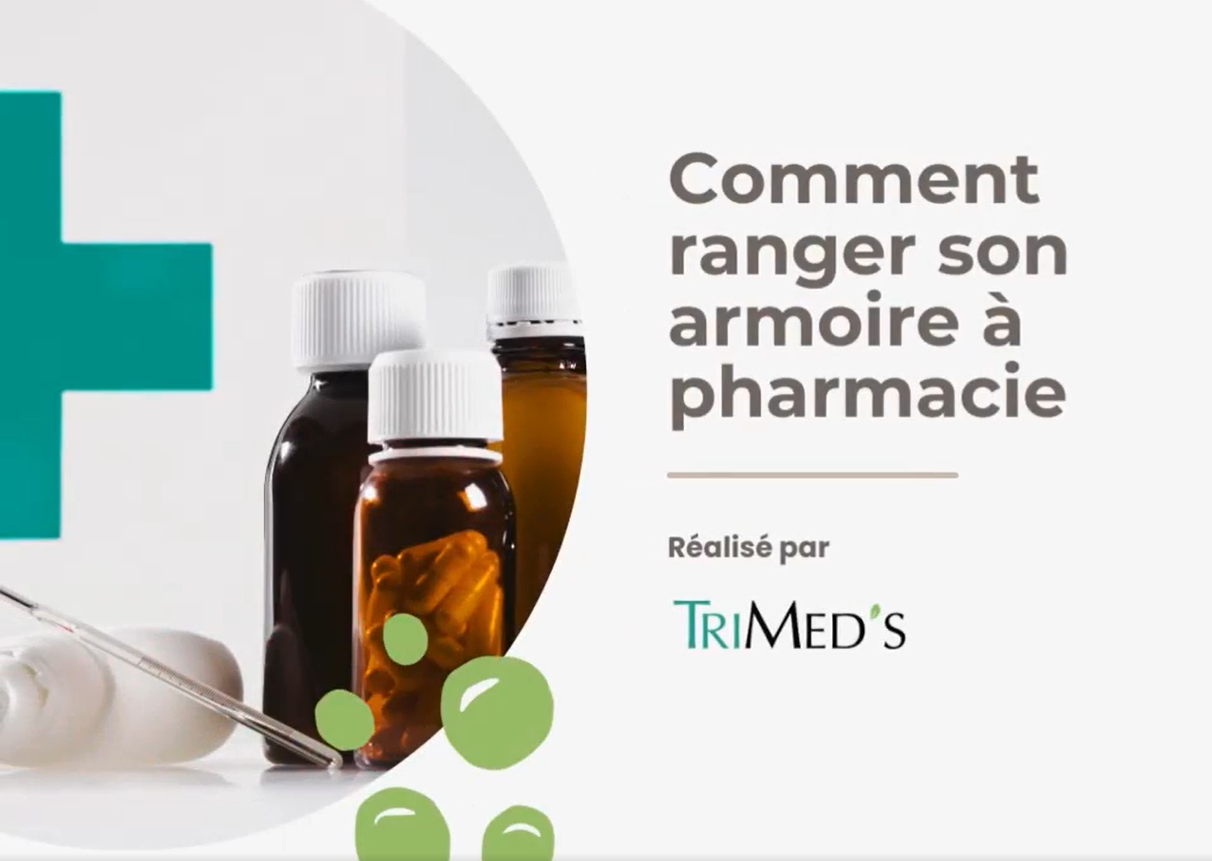
A medicine cabinet is an indispensable item in every home. But you need to know where to put it, what to put in it and how to store it.
TriMed's gives you all the necessary advice to organize your medicine cabinet.
First of all, it is essential to have a first aid kit at home, easily transportable in case of outing or travel. Of course, you will need to equip this kit with other items in case of travel (such as
medicines against motion sickness or seasickness...), but here we are going to indicate you the essential to put in it in any case.
Your first aid kit should contain
A skin antiseptic (spray or single-dose).
Sterile compresses.
Pre-cut bandages.
Hemostatic bandages (in case of nosebleed for example).
Stretch bandages (velpeau or nylex type).
Round-tipped scissors and splinter forceps.
Single-use gloves.
Aspirin and paracetamol;
A bottle of 70° alcohol;
A bottle of uncolored antiseptic.
Arnica for bruises (in case of fall)
A survival blanket.
Let's now look at the essential medicines and pharmaceutical products to have at home.
In your medicine box. You must have :
1 painkiller and antipyretic against fever like paracetamol (form adapted to the adult and form adapted to the child)
1 antihistamine (effective treatment against allergies)
1 medicine for difficult digestion
1 antispasmodic (calms muscular spasms, especially digestive and genito-urinary)
1 anti-nausea medication
1 intestinal antiseptic
1 anti-diarrheal
1 anti-emetic (acts against vomiting and nausea)
1 ointment against bruises
1 anti-inflammatory gel
1 box of heating patches
1 ointment or spray for superficial burns and/or sunburn
1 anti-itching ointment
1 local antiseptic
1 eyewash or eye antiseptic in pods
1 oral rehydration solution (for severe diarrhea)
1 mosquito repellent
1 box of saline solution in pods
1 medical thermometer
1 box of bandages
1 box of sterile compresses
1 roll of plaster
1 box of hemostatic pads (to stop bleeding)
1 pair of scissors
1 pair of tweezers or splinter tweezers
1 pair of vinyl gloves
1 survival blanket
1 box of condoms
1 hydro-alcohol gel
1 box of protective masks
The location of your medicine cabinet:
The location of your medicine cabinet is equally important for a better preservation of your products and a better security.
First of all, it is advisable to gather all your medications in the same place. A place that is protected from humidity, light and heat. Thus, it is preferable to avoid the bathroom and the kitchen.
Choose a place that is easy to access in case of an emergency (not in the cellar, for example, or on the top floor of the house). Your medicine cabinet should be placed in a secure location, locked and positioned high up to prevent access by children.
The storage of medicines:
How to properly organize your medicine cabinet now? This question is as important as the previous ones.
It is important to keep medications in their box with the instructions inside so that you can have an overview of the expiration dates often printed on the box itself.
Vaccines and some opened medicines should be kept in the refrigerator, such as
reconstituted antibiotics.
Organize your cupboard to separate medicines for children from those for adults
and for better efficiency in case of emergency, classify them by pathology.
It is also a good idea to arrange the boxes so that you can read the name of the medication on them without having to take out all the boxes by filing them side by side rather than one behind the other.
If you have several boxes of the same medication, it is best to put the ones with the closest expiration date in front of them to get rid of them first.
The expiration date of medications:
It is essential to check the date mentioned on your boxes or bottles of medication and respect it scrupulously. It is strongly recommended to sort out your medication once every 6 months in order to get rid of expired medication (Be careful! do not throw your expired medication in the garbage, do not pour them down the sink or in the toilet, bring them to your nearest pharmacy instead. There is bound to be a Cyclamed box waiting for you to collect expired products. This is important to avoid contaminating the environment and for a better recycling of these products).
Some medications can be kept for a short time after opening. This is the case for eye drops, oral solutions and syrups. Whenever possible, use single-dose formats.
Caution! Do not use medicines that have changed in appearance (color, smell...).
If you have any questions, or if in doubt, always ask your pharmacist for advice.
